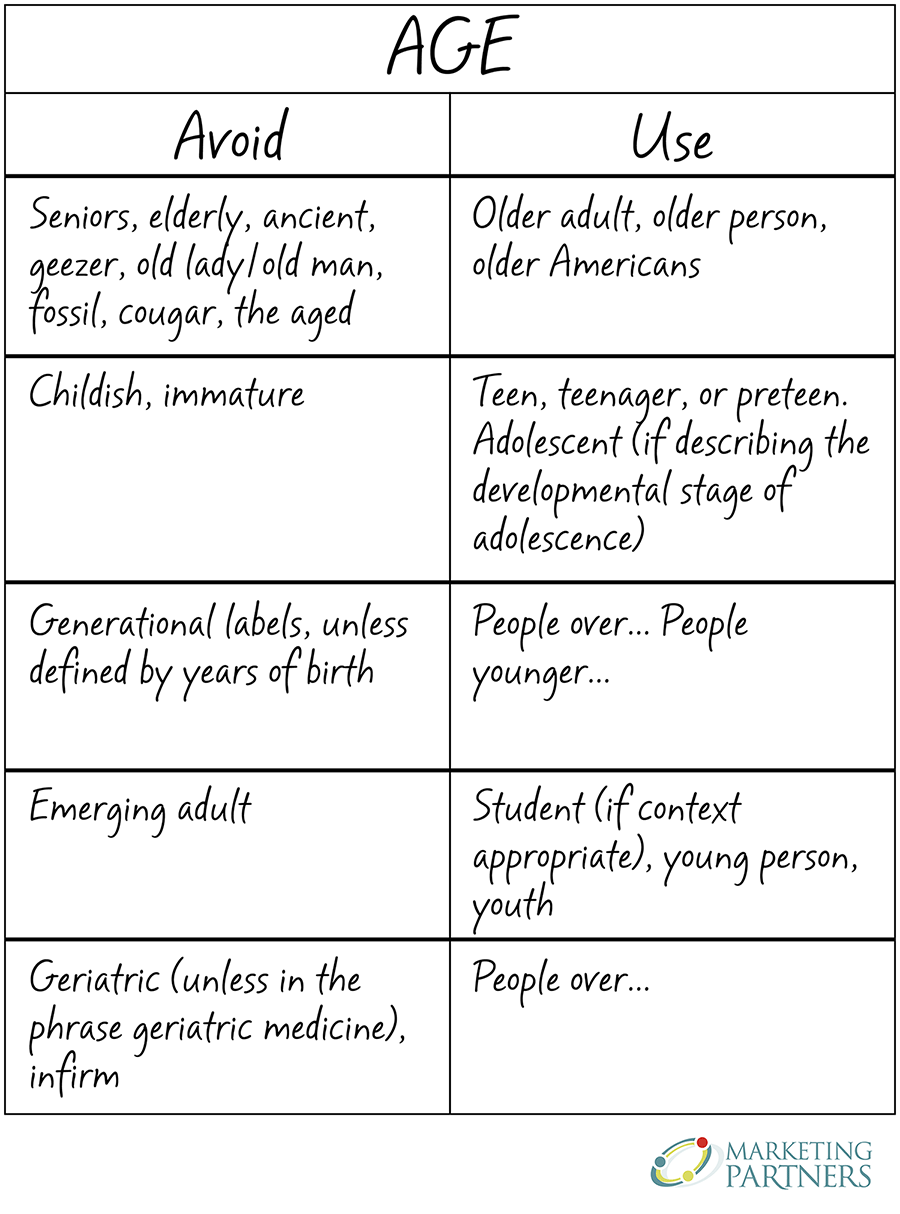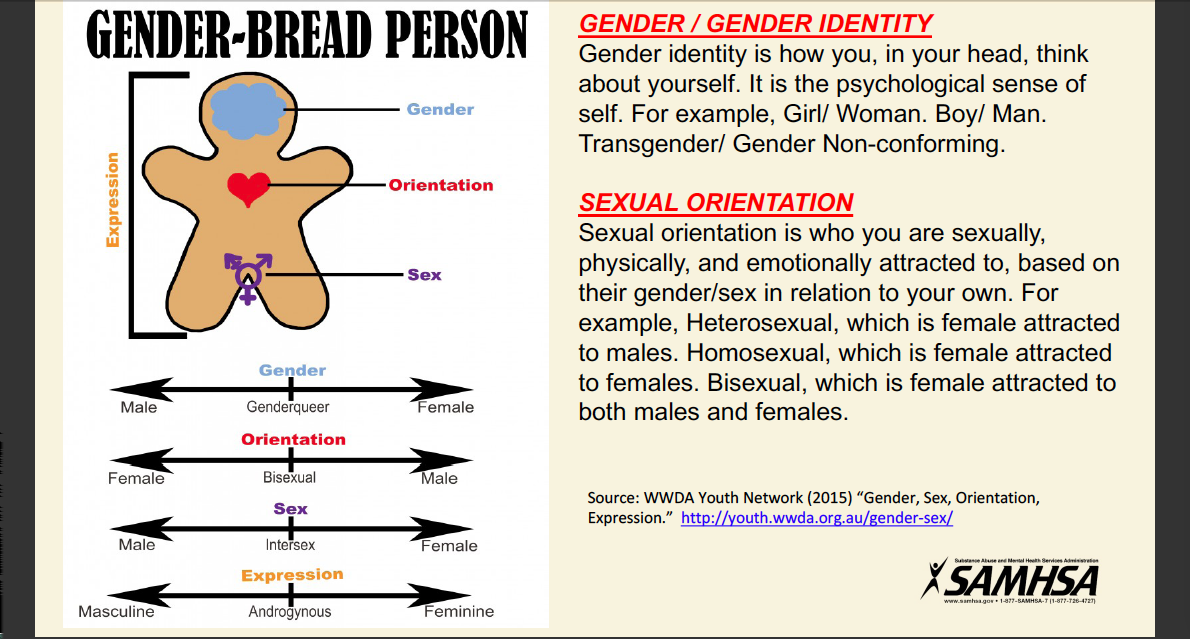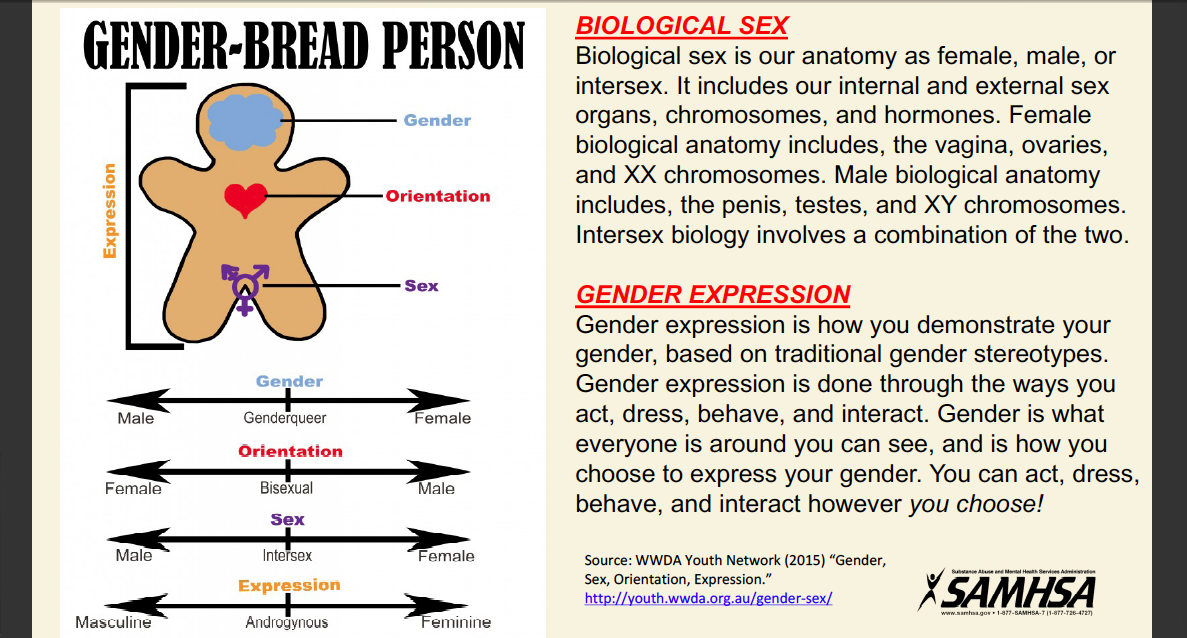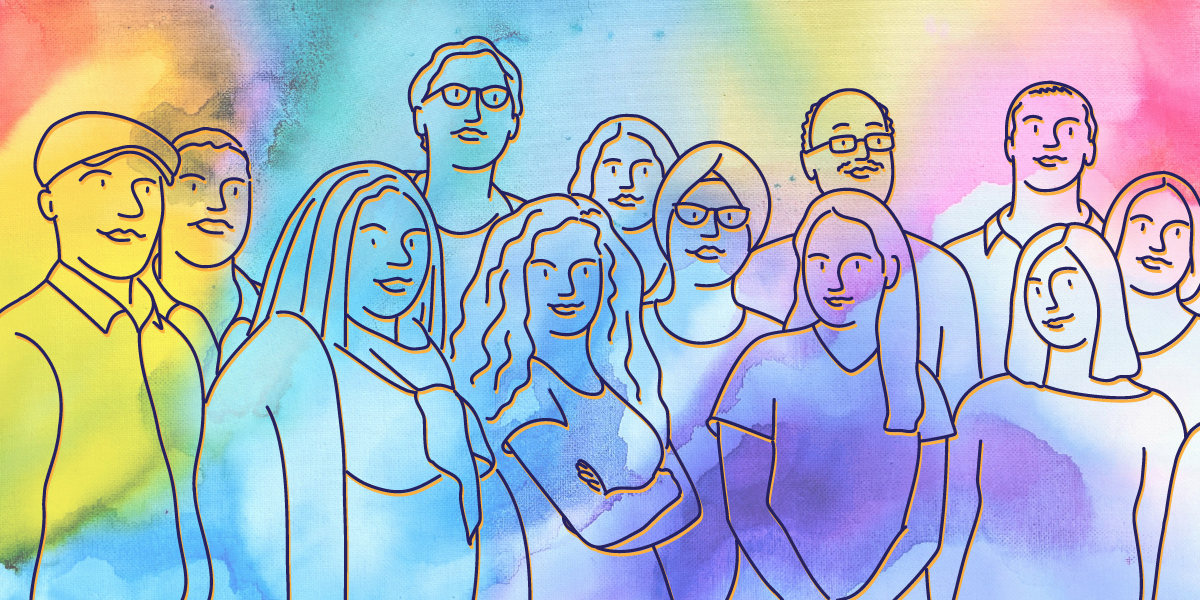The Guide to
Inclusive Language
Table of Contents
Inclusive Language reflects a broad range of identities and perspectives that does not stereotype or demean people based on implicit bias and perceptions of personal characteristics or cultural background.
It is hard to believe...
It’s been more than fifty years since racial and gender discrimination were defined in law, and more than forty years since Section 504 introduced the concept of disability civil rights in the U.S. Yet many people continue to feel uncomfortable having conversations about these subjects. You are a capable communicator, but imagine yourself...
...in a meeting with strangers where you are suddenly concerned about accidentally saying the wrong thing or offending someone. In unfamiliar situations, you may feel like you could easily but inadvertently say something insensitive.
...or at work, where your organization struggles to find the inclusive visual and verbal language to demonstrate your commitment to support diversity through your public communication and marketing.
Sound familiar? Changing old patterns can be intimidating at first. That’s why we created the Guide to Inclusive Language 101. The goal is to help you look at how to reduce the barriers that unconscious biases in your visual and verbal messages can present — in conflict with your desire for clear, inclusive communication — that is, to explore how you can consistently communicate in a way that reduces bias, increases access, and supports diversity and inclusion.
Basic Background
It's the Law
The legal frameworks central to our subject include both business/industry-specific regulations and employment regulations grounded in civil rights and privacy laws. Key laws in the U.S. include:
- Title VII of the Civil Rights Act of 1964 outlaws discrimination based on race, color, religion, sex, or national origin.
- Section 504 of the Rehabilitation Act of 1973 prohibits discrimination based on disability in any program or activity operated by recipients of federal funds. Individuals with disabilities must be provided an equal opportunity to participate in programs and benefit from services, which includes providing appropriate auxiliary aids where necessary to ensure an equal opportunity.
- Section 508, a 1998 amendment to the Rehabilitation Act of 1973, mandates that all electronic and information technology be accessible. Section 508 is the original basis for evolving website design accessibility guidelines.) Note that while there is nothing in Section 508 that requires private web sites to comply unless they are receiving federal funds or under contract with a federal agency, commercial best practices include voluntary standards and guidelines.
- Title II of the Americans with Disabilities Act of 1990 (ADA) prohibits discrimination based on disability by public entities, regardless of whether they receive federal financial assistance.
- Title III of the ADA applies to public accommodations, which specifically include private entities who own or operate facilities open to the public, such as retail stores, restaurants, health clubs, private schools, movie theaters, and so forth.
- Section 504 and Title I of the ADA also prohibit employment discrimination. Complainants may choose whether to pursue such complaints with either the Office of Civil Rights or with the Equal Employment Opportunity Commission.
Though additional state laws and regulations also play a role, it is a desire to go above and beyond legal requirements that challenges many mission-driven organizations.
Unconscious biases make achieving this goal difficult. We all carry implicit, hidden biases from a lifetime of exposure to cultural attitudes about age, gender, race, ethnicity, religion, social class, sexuality, disability status, and nationality.
Changing Demographics
- Yesterday 3 in 4 Americans were Whites. Today, Whites represent about 62 percent of the population.
- Five states are majority–minority as of 2016: Hawaii, New Mexico, California, Texas and Nevada. The District of Columbia is also majority–minority. (Minority is used by the U.S. Census Bureau to refer to everyone other than the non-Hispanic White-alone population.)
- Between 2000 and 2010 more than half of the growth in the total population of the United was due to the increase in the Hispanic/Latino population.
- By the fall of 2014 for the first time the race/ethnicity of the public school population was majority-minority, that is, 50.3 percent other than Non-Hispanic White.
- Between 2000 and 2013, 78 counties in 19 states flipped from majority White to majority minority.
- Lawful immigrants accounted for three-quarters of the foreign-born population in the U.S. in 2015.
- Immigration is projected to drive the growth in U.S. working-age population through at least 2035.
Let’s take a closer look at other dimensions of our population.
- When different types of impairment groups are taken as a whole, people with disabilities make up the largest minority group today at 19 percent of the U.S. population.
- An estimated 2 to 10 percent of the population is gay/lesbian.
- The fastest-growing age groups are those 65 and older. Between 2014 and 2060, the number of older adults is projected to grow from 15 percent to 24 percent of the population, more than doubling in size from 48 million to 98 million. The median age of the population will continue to rise as the Baby Boomer generation (people born between 1946 and 1964) grows older. There will be an increase in workers age 65 and older.
- One in every 5 Americans speaks a language other than English at home.
- Consumer buying power among the four primary U.S. minority groups—African Americans, Hispanic/Latinos, Asians, and American Indians—nearly doubled in the 1990s and continues to grow at a faster rate than the overall U.S. buying power.
Sources: U.S. Census Bureau Classification of Race and Ethnicity [PDF]; Population Projections and Composition [PDF]; American FactFinder tools; Pew Research Center
Changing Cultural and Social Norms
- Today, diversity of thought, or cognitive diversity, is seen as more than age, religion, gender, race, physical ability. It’s about diversity of experience and thinking — how different point of views are accepted and valued.
- Americans’ views toward those who identify as lesbian, gay, bisexual or transgender (LGBT) have changed substantially in recent years, and a majority of U.S. adults now say homosexuality should be accepted by society.
- Full-time enrollment of college students with a disability grew by 45 percent between 2000 and 2010. Part-time enrollment grew by 26 percent. There are also about 250,000 higher education faculty members who have disabilities.
Millennials are more likely to define diversity as pertaining to the individual mix of unique experiences, identities, ideas, and opinions. Prior generations, on the other hand, frame diversity in terms of demographics, equal opportunity, and representation of identifiable demographic characteristics.
– Deloitte survey
Why Inclusive Language Matters
Communication that consistently demonstrates your principles over time builds trust and relationships — the foundation for any mission-driven organization. Communication that offends, demeans, or creates dissonance in the minds of your audiences, employees, partners or investors erodes trust.
Numerous research studies report that communication and work in diverse groups — groups with a broad range of identities, perspectives, backgrounds, ages, and genders — makes us smarter. (Sources: Scientific American, Harvard Business Review.) And according to a McKinsey study, ethnically diverse companies are 35% more likely to financially outperform ethnically homogenous ones, and gender diverse companies are 15% more likely to financially outperform companies lacking gender diversity. (Source: McKinsey)
Communicating your organization authentically understands and values a more diverse and inclusive society can help you:
- Gain market insight and grow into new markets
- Access all available talent and retain top talent
- Develop creative and innovative services and/or products
- Create a more vibrant company culture and positive work environment
- Build relationships with community leaders and external audiences
- Boost brand loyalty and customer satisfaction
Five Principles for Reducing Implicit Bias
1. When writing, speaking, or using images, aim to use examples that reflect a broad range of identities and perspectives. Whenever possible, ask the preferred terminology. One person with a visual disability may prefer “blind,” while another person with a similar disability may prefer “person with low or limited loss of vision.”
2. Differences of any kind should only be mentioned when relevant. Marital status, age, sexual orientation, racial and ethnic identity or the fact that a person has a disability should not be mentioned gratuitously.
3. Use the appropriate level of specificity.
- Not specific: using the word “man” to represent humanity
- Specific: more accurate would be using the phrase “men and women”
- Not specific: at risk children
- Specific: children at risk for early school dropout”
4. Be sensitive to labels.
- Avoid labeling people whenever possible
- If you must use a label, remember to call people what they prefer to be called, keeping in mind that these preferences can change over time. For example, rather than American Indian or Native American, many groups prefer to be referred to by their tribal name, for instance, “…, members of the Cherokee tribe.”
5. Put the person first (e.g., people with diabetes” or “Mary, who uses a screen reader”).
Glossary of Definitions and Shared Language
Accessibility
Accessibility refers to how easily a person with disabilities can negotiate a physical or virtual environment, for example, part of a building, a structure, or a website. Accessibility also refers to the design of structures, products, devices, services, or environments for people who experience disabilities.
Diversity
Human diversity means differences among people. Diversity of thought, or cognitive diversity, is more than age, religion, gender, race, physical ability. It’s about how different point of views are accepted and valued. Diverse workplaces are composed of employees with varying characteristics including, but not limited to: religious and political beliefs, gender, race, ethnicity, education, socioeconomic background, sexual orientation, and geographic location.
Inclusion
Seeking out, identifying, understanding, and removing barriers to full participation and belonging; intentionally including additional difference in a group or process; and encouraging high levels of both individuality and belonging. Inclusive Language does not exclude, stereotype, or demean people based on perceptions of personal characteristics or cultural background.
Ageism
Ageism is discrimination against older people due to negative and inaccurate stereotypes. Ageists view a person’s age number or chronological age as a marker of essential characteristics or type, leading to stereotyping and suppressing the experience and true nature of individuals.
Adultism
Adultism is a system of beliefs, attitudes, and actions that devalue and dehumanize young people, denigrates youth experiences, and dismisses their ideas.
BAME
An acronym for "Black, Asian and Minority Ethnic," primarily used in the U.K. to describe any person who is not white or Caucasian.
BIPOC
An acronym for "Black, Indigenous, and People of Color," used primarily in the United States to describe any person who is not white or Caucasian.
Disability
A disability is a physical or mental illness, injury, or condition that limits a person's movements, senses, or activities. Disabilities require the use of language that maintains the integrity of the individual as a person first (the person's name or pronoun should come first), and descriptions of the disability should not be used as an adjective modifying the person (e.g., "a man who has bipolar disorder” is acceptable use.)
Discrimination
Discrimination occurs when a person, or a group of people, is treated less favorably than another person or group because of their background or certain perceived personal characteristics.
Gender
Gender is cultural and refers to one’s role, not one’s biological sex. Gender identity is how a person thinks about themselves, for example: girl/woman, boy/man, transgender/gender non-conforming.
HUGs
An acronym for 'Historically Underrepresented Groups.' Given changing U.S. demographics, it is a more a more accurate term than “minority” and a more inclusive term than “people of color” because depending on the context, discrimination and bias may be based on gender, age, disability, religion, race and ethnicity, or socio-economic class.
Immigrant/Refugee/Expat
An immigrant is someone who chooses to resettle to another country. The United States has a legal process for an immigrant to seek legal residency and eventually citizenship. A refugee is someone who has fled his or her home country. Refugees can apply for asylum in the United States. The U.S. Citizenship and Immigration Services says: "Refugees are generally people outside of their country who are unable or unwilling to return home because they fear serious harm.” An expatriate, or expat, is a person living in a country other than that of their citizenship. The term expat popularly refers to professionals or skilled workers sent abroad by their employers.
Impostor Syndrome
A collection of feelings of inadequacy that persist despite evident success.
LGBTQIA
Abbreviation for Lesbian, Gay, Bisexual, Transgender, Queer, Intersex, and Asexual, although there are several variations. LGBTQ+ is an umbrella term that is used to refer to the community as a whole.
Microaggression
A comment or action that is subtly and often unintentionally hostile or demeaning to a member of a minority or marginalized group.
POC
An acronym standing for “Person of Color.” This term is used primarily in the United States to describe any person who is not white or Caucasian.
Privilege
A special right, advantage, or immunity granted or available only to a particular person or group, often implicitly and ‘invisibly’ to those who have it.
Racial and ethnic identity
Race refers to a system of classifying individuals based on observable characteristics that are genetically determined but not always consistent. Ethnicity refers to a sizable group of people who share a common and distinctive racial, national, religious, linguistic, or cultural heritage. Racial and ethnic identity can change over time and become dated; use commonly accepted designations such as census categories.
Sexual orientation
Sexual orientation has to do with a pattern of attraction, behavior, identity, and social contact and may be different from sexual preference. Sexual partner preference suggests voluntary choice, while it is widely accepted today that sexual orientation is not a choice.
Tokenism
The practice of doing something (such as hiring, promoting, or otherwise lifting up a person who belongs to a minority group) only to prevent criticism and give the appearance that people are being treated fairly.
Transgender/Gender Diverse
Transgender/gender diverse, or trans for short, is when you do not exclusively identify as the gender you were assigned at birth. Cisgender is the opposite of transgender.
Trigger
An experience which causes an individual, normally unintentionally and indirectly, to recall previous trauma.
Unconscious or Implicit Bias
Social stereotypes about certain groups of people that individuals form outside our own conscious awareness. Everyone holds unconscious beliefs about various social and identity groups, and these biases stem from the human tendency to organize social worlds by categorizing. Implicit bias refers to the attitudes or stereotypes that affect our understanding, actions, and decisions in an unconscious manner.
Underrepresented Groups
Groups who have traditionally not had equal access to economic opportunities because of discrimination or other societal barriers. This may vary by context and geography but can include race, gender, ethnicity, sexual-orientation, disability, or low-income status.
Womxm
Womxn is an alternative spelling of "women" that is considered a more inclusive term to explicitly include non-cisgender women. The term's advocates emphasize its inclusive nature as its key benefit. "While hard to pronounce, “womxn” is perhaps the most inclusive word yet using an “x” to tinker with the word's literal approach to gender in a similar way as “Latinx,” which has become an ungendered alternative to words like “Latino” and “Latina.”
Guidelines and Examples by Topic
Age
General Principles for Reducing Bias about Age
- Most times there is no need to refer to a person’s age. When the need arises, list the specific age number, rather than assigning a category that may be vague and create negative connotations.
- Age ranges or generational cohort should be specific, or defined by birth date, for example, “baby boomers, born between 1946 and 1964”.
- Whenever possible, ask the preferred terminology. One person may prefer “senior,” while another person with the same age number may prefer “older adult.”
- Avoid using age-related terminology to describe a situation metaphorically, especially if the phrasing is meant as an insult, or is used flippantly.
- Do not use language that patronizes, sentimentalizes, distorts, or ignores people based on their age number.
- Avoid negative, value-laden terms that overextend the limitations of a young person’s developmental stage or the severity of an older person’s health.
- To ensure people of all ages have a voice in society, it is vital to reject a purely “age-number” framing of life stage, to always use medical terminology accurately, and to use narratives that support people of all ages.
Inclusive Language Examples When Communicating about Age

Disability
General Principles for Reducing Bias about Disability
- Disabilities require the use of language that maintains the integrity and dignity of the individual
- Put the person first (e.g., people with diabetes” or “Mary, who uses a screen reader”)
- Whenever possible, ask the preferred terminology. One person with a visual disability may prefer “blind,” while another person with a similar disability may prefer “person with low or limited loss of vision.”
Inclusive Language Examples When Communicating about Disability

Gender and Sexual Orientation
General Principles for Reducing Bias about Gender and Sexual Orientation
- Gender is cultural and refers to one’s role, not one’s biological sex. Gender identity is how a person thinks about themselves, for example: girl/woman, boy/man, transgender/gender non-conforming.
- Sexual orientation has to do with a pattern of attraction, behavior, identity, and social contact and may be different from sexual preference. Sexual partner preference suggests voluntary choice, while it is widely accepted today that sexual orientation is not a choice.
- Avoid sexist terminology based on demeaning assumptions or stereotypes about gender
- Ask: “What is your preferred pronoun?”
- Only mention gender or sex when it is necessary to do so.
One of our favorite summaries of the gender-sex-orientation distinctions is the Gender-Bread Person illustration with key terms below that we first saw in a Substance Abuse and Mental Health Services Administration (SAMHSA) webinar.


 Source: WWDA Youth Network (2015) “Gender, Sex, Orientation, Expression.” http://youth.wwda.org.au/gender-sex/
Source: WWDA Youth Network (2015) “Gender, Sex, Orientation, Expression.” http://youth.wwda.org.au/gender-sex/
And here is our favorite video introduction to Being Trans, Gender Identity, and What It's All About, produced by a youth group in Australia.
Inclusive Language Examples When Communicating about Gender and Sexual Orientation

Resources and Notes
Resources for Diversity & Inclusion Language
AGE:
When It Comes to Older Adults, Language Matters: Journal of the American Geriatrics Society Adopts Modified American Medical Association Style
DISABILITY:
National Center on Disability and Journalism, Disability Language Style Guide
Research and Training Center on Independent Living, Guidelines for reporting and writing about people with disabilities (8th Edition), University of Kansas.
GENDER:
Nature, Nurture, And Our Evolving Debates About Gender - The Hidden Brain
GLAAD Media Reference Guide - 10th Edition
More on the Business Case for Gender Parity - re:Work with Google
Trans 101 Gender Diversity Crash Course (Booklet and Videos)
The Handbook of Nonsexist Writing: For Writers, Editors and Speakers, by Casey Miller, Kate Swift (OCLC WorldCat® listing for library near you)
UNESCO’s Guidelines on Gender-Neutral Language [pdf]
Resource on Sharing Personal Pronouns
GENERAL:
Publication Manual of the American Psychological Association, General Guidelines for Reducing Bias. [PDF]
Google’s Unconscious Bias training video
Visit the UnderstandingPrejudice.org website to take the baseline survey and then judge a series of advertisements to see which ones, if any, involve prejudice or discrimination. You may be surprised by what you learn.
NEURODIVERSITY and NEUROTYPICAL
Leading and Managing a Neurodiverse Workforce, podcast, Insight at Work with Ken Blackwell and guest, Susan Fitzell
The Language of Neurodiversity: Terms and Definitions in the Age of Inclusivity, Medium (members only paywall)
RACE and ETHNICITY:
A Collection of Key Race Equity and Inclusion Resources, ANNIE E. CASEY FOUNDATION
Racial Equality or Racial Equity? The Difference it Makes, Race Matters Institute
Summary
We created the Guide to Inclusive Language to help you communicate in a way that embraces openness to differences among people, perspectives, cultures, backgrounds, skin color, language, age, sexual orientation, and gender. We hope you find it useful — and invite you to contact us with suggestions.
"Inclusion is the process. Diversity is the result." -- MaryAnne Howland

![Download Your Flashcard on Ageism Language [PDF]](https://no-cache.hubspot.com/cta/default/395217/1596a67d-e5c5-4b68-ace6-d9e6663abffa.png)
![Download Flashcard for Inclusive Language on Disability [PDF]](https://no-cache.hubspot.com/cta/default/395217/c09f4874-3e09-4803-80d3-932055021dc4.png)
![Download Flashcard for Inclusive Gender-Neutral & Sexual Orientation Language [PDF]](https://no-cache.hubspot.com/cta/default/395217/3a6c05a6-19e0-46e5-949c-f223253a84f7.png)